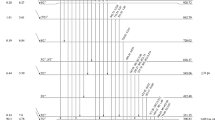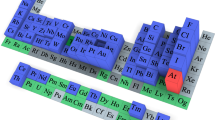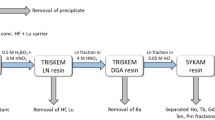Abstract
PROF. E. O. LAWRENCE, of the University of California, gave us a plate of molybdenum which had been irradiated with deuterons in the Berkeley cyclotron. The plate showed a strong radioactivity due to more than one body. The half-value periods are of the order of magnitude of some months. A chemical investigation of the activity ruled out any radioactive isotopes of zirconium, niobium, molybdenum or ruthenium, and shows most probably that the activity is due to isotopes of atomic number 43 (masurium of I. and W. Noddack).
This is a preview of subscription content, access via your institution
Access options
Subscribe to this journal
Receive 51 print issues and online access
$199.00 per year
only $3.90 per issue
Buy this article
- Purchase on Springer Link
- Instant access to full article PDF
Prices may be subject to local taxes which are calculated during checkout
Similar content being viewed by others
References
Geilmann and Weibke, Z. anorg. allgem. Chemie, 199, 120 (1931).
Author information
Authors and Affiliations
Rights and permissions
About this article
Cite this article
PERRIER, C., SEGRÈ, E. Radioactive Isotopes of Element 43. Nature 140, 193–194 (1937). https://doi.org/10.1038/140193b0
Issue Date:
DOI: https://doi.org/10.1038/140193b0
This article is cited by
-
Name game: the naming history of the chemical elements—part 3—rivalry of scientists in the twentieth and twenty-first centuries
Foundations of Chemistry (2023)
-
Highly selective separation of medical isotope 99mTc from irradiated 100Mo target using PEG-based resins
Journal of Radioanalytical and Nuclear Chemistry (2023)
-
The first synthetic element
Nature (2019)
-
Where Mendeleev was wrong: predicted elements that have never been found
ChemTexts (2019)
-
99mTc production via the (γ, n) reaction on natural Mo
Journal of Radioanalytical and Nuclear Chemistry (2018)
Comments
By submitting a comment you agree to abide by our Terms and Community Guidelines. If you find something abusive or that does not comply with our terms or guidelines please flag it as inappropriate.



